2005 Hyundai Azera coolant
[x] Cancel search: coolantPage 244 of 297
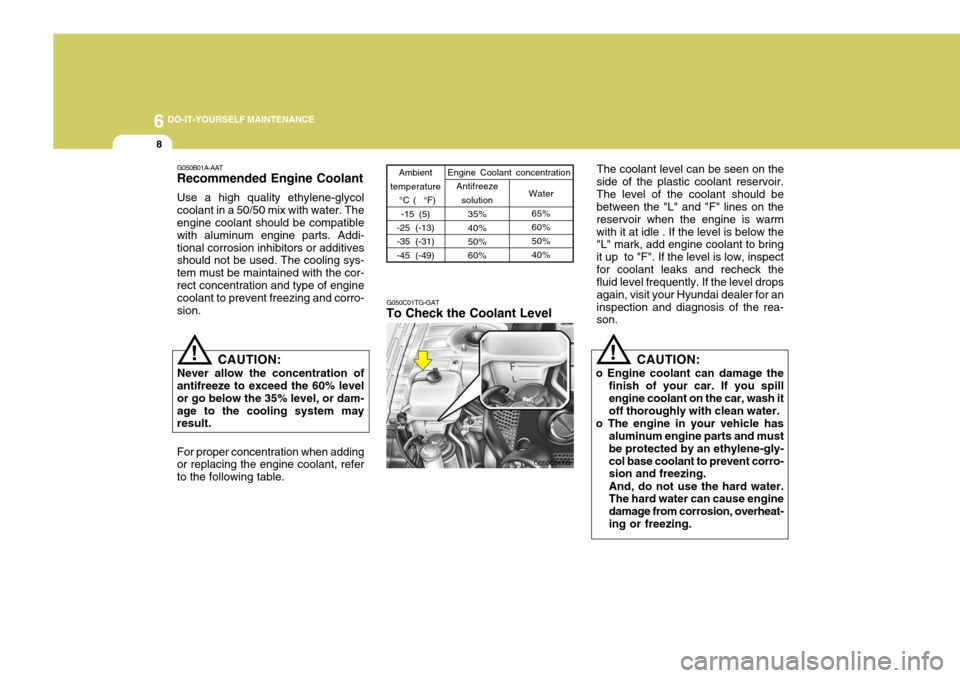
6 DO-IT-YOURSELF MAINTENANCE
8
!
The coolant level can be seen on the
side of the plastic coolant reservoir. The level of the coolant should be between the "L" and "F" lines on the reservoir when the engine is warmwith it at idle . If the level is below the "L" mark, add engine coolant to bring it up to "F". If the level is low, inspectfor coolant leaks and recheck the fluid level frequently. If the level drops again, visit your Hyundai dealer for aninspection and diagnosis of the rea- son.
G050C01TG-GAT
To Check the Coolant Level
G050C01TG
Ambient
temperature °C ( °F)
-15 (5)
-25 (-13) -35 (-31)-45 (-49)
65% 60%50%40%
35%40% 50% 60% Water
Antifreeze
solution
Engine Coolant concentration
CAUTION:
o Engine coolant can damage the finish of your car. If you spill engine coolant on the car, wash it off thoroughly with clean water.
o The engine in your vehicle has aluminum engine parts and mustbe protected by an ethylene-gly-col base coolant to prevent corro- sion and freezing. And, do not use the hard water. The hard water can cause engine damage from corrosion, overheat-ing or freezing.
!
G050B01A-AAT
Recommended Engine Coolant
Use a high quality ethylene-glycol coolant in a 50/50 mix with water. The engine coolant should be compatible with aluminum engine parts. Addi-tional corrosion inhibitors or additives should not be used. The cooling sys- tem must be maintained with the cor-rect concentration and type of engine coolant to prevent freezing and corro- sion.
CAUTION:
Never allow the concentration of antifreeze to exceed the 60% level or go below the 35% level, or dam-age to the cooling system may result. For proper concentration when adding or replacing the engine coolant, refer to the following table.
Page 245 of 297

6
DO-IT-YOURSELF MAINTENANCE
9
!WARNING:
The cooling fan is controlled by engine coolant temperature and may sometimes operate even when theengine is not running. Use extreme caution when working near the blades of the coolant fan so that youare not injured by a rotating fan blade. As the engine coolant tem- perature decreases, the fan will au-tomatically shut off. This is a nor- mal condition.
SPARK PLUGS
G060A01TG-GAT
G060A01L
Your engine was originally equipped with Iridium-tipped spark plugs (For unleaded only).Iridium-tipped spark plugs will lastlonger than conventional type sparkplugs and can be identified by blue lines on the ceramic shell. NOTE: Do not clean or regap Iridium- tipped spark plugs. G060B01TG-GAT Replacing the Spark Plugs The spark plugs should be changed at the intervals specified in the ve- hicle maintenance schedule in Sec- tion 5 or whenever engine perfor-mance indicates they should be changed. Symptoms that suggest poor spark plug performance include en-gine misfiring under load, loss of fuel economy, poor acceleration, etc. When spark plugs are replaced, al-ways use spark plugs recommended by Hyundai. The use of other spark plugs can result in loss of perfor-mance, radio interference or engine damage. NOTE:
o It is recommended that spark
plugs should be changed by an authorized Hyundai dealer.
o When replacing the spark plugs,
always use the genuine parts rec- ommended.
Unleaded : 1.0~1.1 mm Leaded : 0.7~0.8 mm
Page 252 of 297
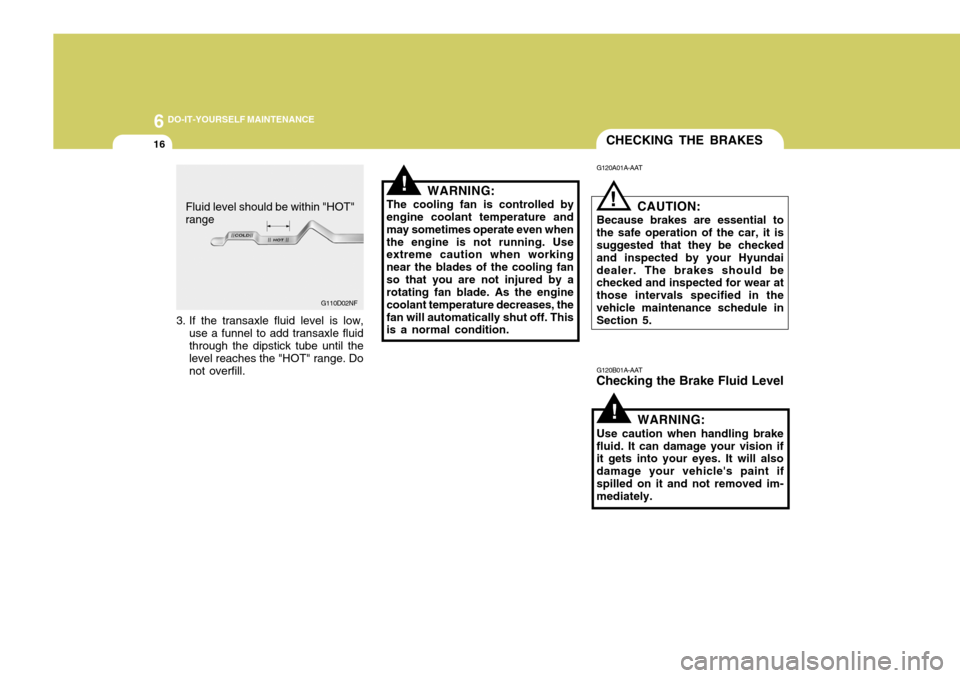
6 DO-IT-YOURSELF MAINTENANCE
16
!
!
G110D02NF
Fluid level should be within "HOT"
range WARNING:
The cooling fan is controlled by engine coolant temperature and may sometimes operate even whenthe engine is not running. Use extreme caution when working near the blades of the cooling fanso that you are not injured by a rotating fan blade. As the engine coolant temperature decreases, thefan will automatically shut off. This is a normal condition.
3. If the transaxle fluid level is low,
use a funnel to add transaxle fluid through the dipstick tube until the level reaches the "HOT" range. Do not overfill.
CHECKING THE BRAKES
G120A01A-AAT G120B01A-AAT
Checking the Brake Fluid Level
! CAUTION:
Because brakes are essential to the safe operation of the car, it is suggested that they be checked and inspected by your Hyundaidealer. The brakes should be checked and inspected for wear at those intervals specified in thevehicle maintenance schedule in Section 5.
WARNING:
Use caution when handling brake fluid. It can damage your vision if it gets into your eyes. It will also damage your vehicle's paint ifspilled on it and not removed im- mediately.
Page 261 of 297
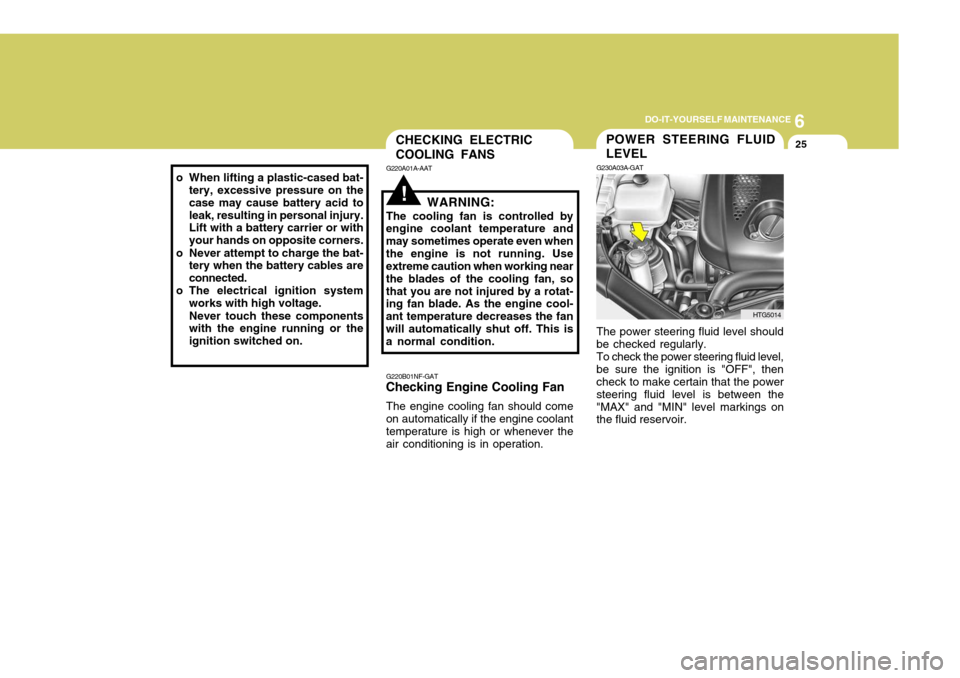
6
DO-IT-YOURSELF MAINTENANCE
25
!
CHECKING ELECTRIC COOLING FANS
G220A01A-AAT
WARNING:
The cooling fan is controlled by
engine coolant temperature and may sometimes operate even whenthe engine is not running. Use extreme caution when working near the blades of the cooling fan, sothat you are not injured by a rotat- ing fan blade. As the engine cool- ant temperature decreases the fanwill automatically shut off. This is a normal condition.
G220B01NF-GAT
Checking Engine Cooling Fan
The engine cooling fan should come on automatically if the engine coolant temperature is high or whenever the air conditioning is in operation.POWER STEERING FLUID LEVEL
G230A03A-GAT The power steering fluid level should be checked regularly.To check the power steering fluid level,be sure the ignition is "OFF", then check to make certain that the power steering fluid level is between the"MAX" and "MIN" level markings on the fluid reservoir.
HTG5014
o When lifting a plastic-cased bat-
tery, excessive pressure on the case may cause battery acid toleak, resulting in personal injury. Lift with a battery carrier or with your hands on opposite corners.
o Never attempt to charge the bat- tery when the battery cables areconnected.
o The electrical ignition system works with high voltage. Never touch these components with the engine running or the ignition switched on.
Page 262 of 297
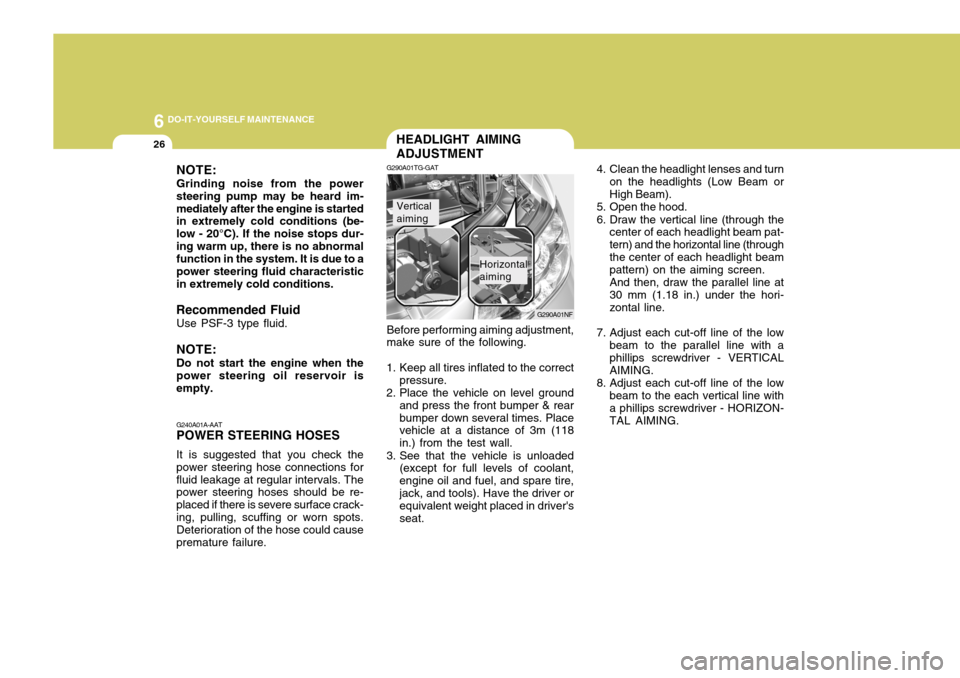
6 DO-IT-YOURSELF MAINTENANCE
26HEADLIGHT AIMING ADJUSTMENT
G290A01TG-GAT
G290A01NF
Before performing aiming adjustment, make sure of the following.
1. Keep all tires inflated to the correct pressure.
2. Place the vehicle on level ground and press the front bumper & rear bumper down several times. Place vehicle at a distance of 3m (118 in.) from the test wall.
3. See that the vehicle is unloaded (except for full levels of coolant,engine oil and fuel, and spare tire,jack, and tools). Have the driver or equivalent weight placed in driver's seat.
Vertical aiming
Horizontal aiming 4. Clean the headlight lenses and turn
on the headlights (Low Beam or High Beam).
5. Open the hood.
6. Draw the vertical line (through the center of each headlight beam pat- tern) and the horizontal line (throughthe center of each headlight beam pattern) on the aiming screen. And then, draw the parallel line at 30 mm (1.18 in.) under the hori- zontal line.
7. Adjust each cut-off line of the low beam to the parallel line with a phillips screwdriver - VERTICAL AIMING.
8. Adjust each cut-off line of the low beam to the each vertical line with a phillips screwdriver - HORIZON-TAL AIMING.
NOTE: Grinding noise from the power steering pump may be heard im-mediately after the engine is started in extremely cold conditions (be- low - 20°C). If the noise stops dur-ing warm up, there is no abnormal function in the system. It is due to a power steering fluid characteristicin extremely cold conditions.
Recommended Fluid Use PSF-3 type fluid. NOTE: Do not start the engine when the power steering oil reservoir is empty. G240A01A-AAT POWER STEERING HOSES It is suggested that you check the power steering hose connections forfluid leakage at regular intervals. The power steering hoses should be re- placed if there is severe surface crack-ing, pulling, scuffing or worn spots. Deterioration of the hose could cause premature failure.
Page 279 of 297
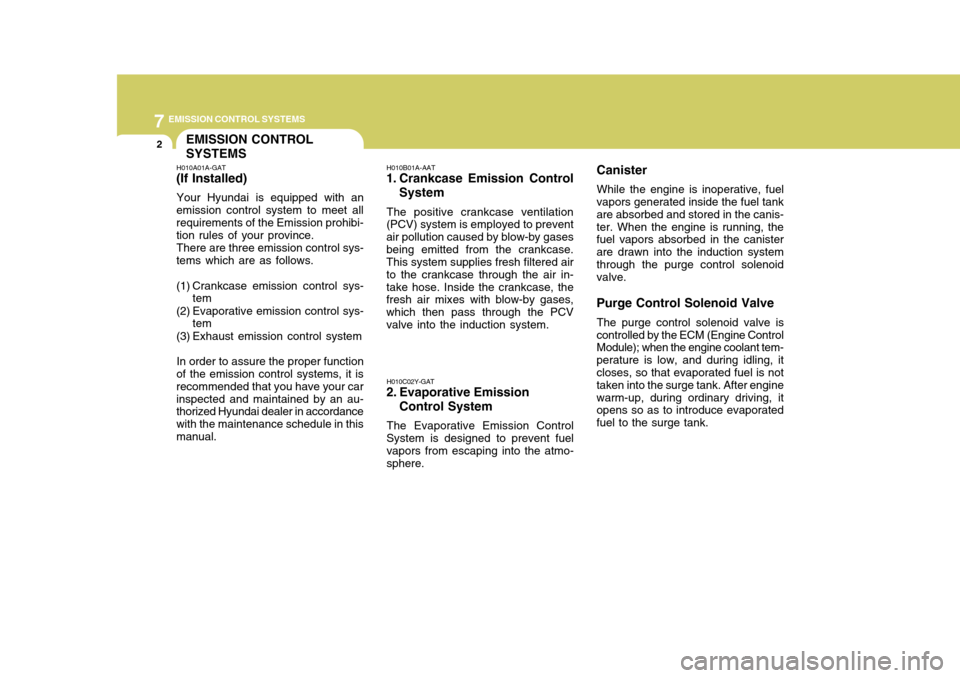
7EMISSION CONTROL SYSTEMS
2EMISSION CONTROL SYSTEMS
H010A01A-GAT
(If Installed)
Your Hyundai is equipped with an
emission control system to meet all requirements of the Emission prohibi- tion rules of your province.
There are three emission control sys-
tems which are as follows.
(1) Crankcase emission control sys- tem
(2) Evaporative emission control sys- tem
(3) Exhaust emission control system
In order to assure the proper function
of the emission control systems, it is recommended that you have your carinspected and maintained by an au- thorized Hyundai dealer in accordance with the maintenance schedule in thismanual. H010B01A-AAT
1. Crankcase Emission Control
System
The positive crankcase ventilation
(PCV) system is employed to preventair pollution caused by blow-by gasesbeing emitted from the crankcase. This system supplies fresh filtered air to the crankcase through the air in-take hose. Inside the crankcase, the fresh air mixes with blow-by gases, which then pass through the PCVvalve into the induction system.
H010C02Y-GAT
2. Evaporative Emission
Control System
The Evaporative Emission Control
System is designed to prevent fuelvapors from escaping into the atmo-sphere. Canister
While the engine is inoperative, fuel
vapors generated inside the fuel tankare absorbed and stored in the canis-ter. When the engine is running, the fuel vapors absorbed in the canister are drawn into the induction systemthrough the purge control solenoid valve. Purge Control Solenoid Valve
The purge control solenoid valve is
controlled by the ECM (Engine Control Module); when the engine coolant tem- perature is low, and during idling, it closes, so that evaporated fuel is not taken into the surge tank. After enginewarm-up, during ordinary driving, it opens so as to introduce evaporated fuel to the surge tank.
Page 291 of 297
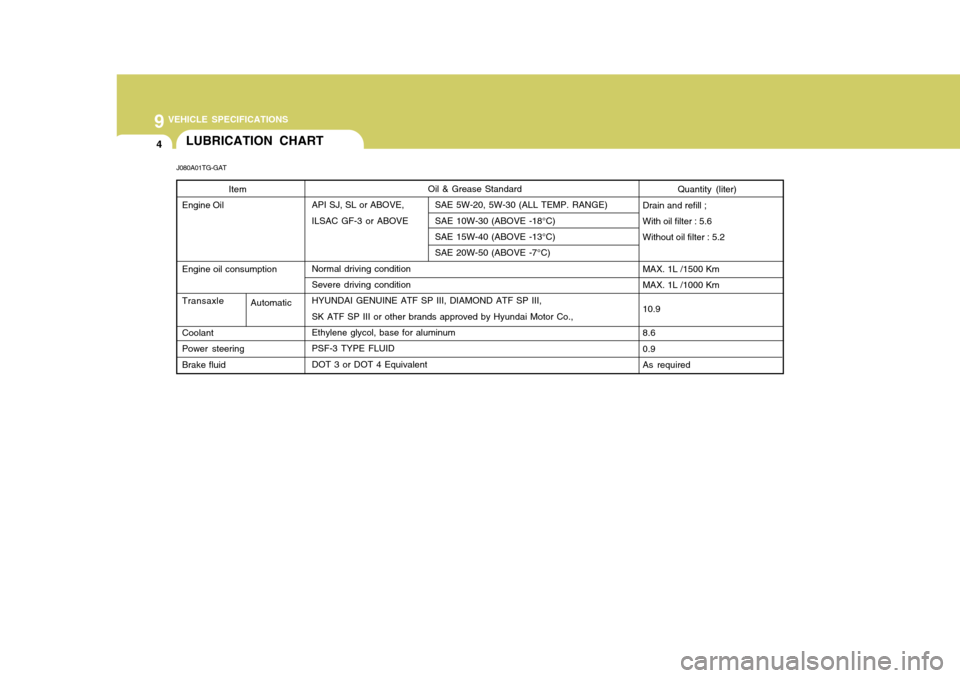
9 VEHICLE SPECIFICATIONS
4
Oil & Grease Standard
API SJ, SL or ABOVE, SAE 5W-20, 5W-30 (ALL TEMP. RANGE)
ILSAC GF-3 or ABOVE SAE 10W-30 (ABOVE -18°C)
SAE 15W-40 (ABOVE -13°C) SAE 20W-50 (ABOVE -7°C)
Normal driving condition Severe driving condition HYUNDAI GENUINE ATF SP III, DIAMOND ATF SP III, SK ATF SP III or other brands approved by Hyundai Motor Co.,Ethylene glycol, base for aluminum PSF-3 TYPE FLUID DOT 3 or DOT 4 EquivalentLUBRICATION CHART
J080A01TG-GAT
Quantity (liter)
Drain and refill ; With oil filter : 5.6 Without oil filter : 5.2 MAX. 1L /1500 Km MAX. 1L /1000 Km 10.98.6 0.9 As required
Item
Engine Oil Engine oil consumption TransaxleCoolant Power steeringBrake fluid
Automatic
Page 294 of 297

10
INDEX
3
Console Box .............................................................. 1-96
Cooling Fans ............................................................. 6-25
Corrosion protection
Cleaning the interior .................................................. 4-5
Protecting your Hyundai from corrosion ................... 4-2
Washing and waxing ................................................. 4-4
Cruise Control .......................................................... 1-109
D Defrosting/Defogging ................................................ 1-119
Door
Central door locks .................................................. 1-12
Door edge warning light ........ ................................1-107
Door locks ................................................................ 1-9
Locking and unlocking front door with a key .......... 1-10
Drink Holder ............................................................... 1-87
Drive Belt ................................................................... 6-21
Driving Driving for economy ............................................... 2-14
Smooth corneri ng .................................................... 2-16
Winter driving .......................................................... 2-16
E Electronic Stability Program (ESP) ...........................2-11
Emission Contro l System ............................................ 7-2
Engine Before starting the engine ........................................ 2-3Compartment ............................................................ 6-2
Coolant ..................................................................... 6-7 Coolant temperature gauge
.....................................1-71
If the engine overheats ............................................. 3-4
Number ..................................................................... 8-2
Oil ............................................................................. 6-4 Starting ..................................................................... 2-5
Engine Exhaust Can Be Dangerous ............................ 2-2
F
Fan Speed Control ............. ...........................1-115, 1-125
Fog Light Switch Front ....................................................................... 1-79
Rear ........................................................................ 1-80
Front Seats
Active headrests ..................................................... 1-23
Adjustable front seats ............................................. 1-21
Adjustable headrests .............................................. 1-22
Adjusting seat forward and rearward .......................1-21
Adjusting seatback angle ....................................... 1-21
Power seat ............................................................. 1-24
Fuel Capacity ................................................................... 9-2
Gauge ..................................................................... 1-70
Recommendations .................................................... 1-2
Fuel Filler Lid Remote release .................................................... 1-103
Fuse Panel Description ............................................. 6-37
Fuses ........................................................................ 6-21